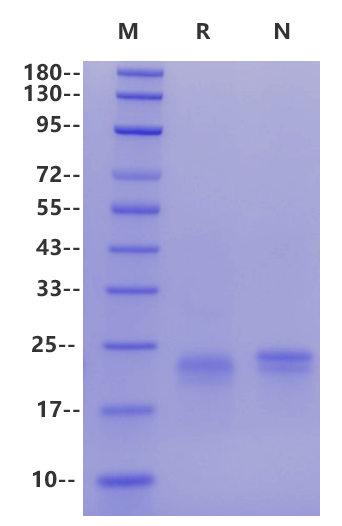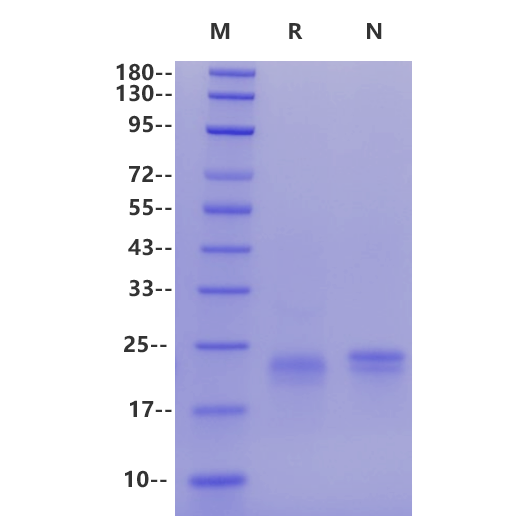Product Details
Product Details
Product Specification
| Species | Human |
| Synonyms | DLL3, Delta3, delta-like 3 (Drosophila), delta-like protein 3, Pudgy, SCDO1, SCDO1delta3 |
| Accession | Q9NYJ7 |
| Amino Acid Sequence | Ser312-Arg490, with C-terminal His |
| Expression System | HEK293 |
| Molecular Weight | 20-24kDa |
| Purity | >95% by SDS-PAGE |
| Endotoxin | <0.1EU/μg |
| Conjugation | Unconjugated |
| Tag | His Tag |
| Physical Appearance | Lyophilized Powder |
| Storage Buffer | PBS, pH7.4 |
| Reconstitution | Reconstitute at 0.1-1 mg/ml according to the size in ultrapure water after rapid centrifugation. |
| Stability & Storage | · 12 months from date of receipt, lyophilized powder stored at -20 to -80℃. · 3 months, -20 to -80℃ under sterile conditions after reconstitution. · 1 week, 2 to 8℃ under sterile conditions after reconstitution. · Please avoid repeated freeze-thaw cycles. |
| Reference |
1、Ladi E. et al. (2005) The divergent DSL ligand DLL3 does not activate Notch signaling but cell autonomously attenuates signaling induced by other DSL ligands. J Cell Biol. 170: 983-992. 2、Xiu M X. et al. (2020) The role of DLLs in cancer: a novel therapeutic target. Onco Targets Ther. 13: 3881-3901. |
Background
Delta-like protein 3 (DLL3) is a transmembrane protein that belongs to the Delta/Serrate/Lag-2 (DSL) family of Notch ligands. Mature human DLL3 consists of a 466 amino acid (aa) extracellular domain (ECD) with one DSL domain and six EGF-like repeats, a 21 aa transmembrane segment, and a 105 aa cytoplasmic domain. Within the ECD, human DLL3 shares 86% aa sequence identity with mouse and rat DLL3. DLL3 is known as a divergent DSL ligand since it does not function in similar manner as the rest of DSL ligands. It does not activate Notch signaling through trans-activation, but autonomously attenuates signaling induced by other DSL ligands. A loss-of-function mutation of DLL3 is linked to axial skeletal defects in the spondylocostal dysplasia, which is linked to abnormal Notch signaling. DL-3 promotes proliferation and inhibits apoptosis of cancer cells. The proliferative effect mediated by DLL3 is thought to be due to increased Akt phosphorylation in cancer cells.
The Notch pathway is a highly conserved cell signaling pathway that is implicated in malignant transformation, cell proliferation, cycle arrest, and apoptosis, epithelial to mesenchymal transition, and suppression of neuroendocrine differentiation. The Notch signaling pathway is initiated by the binding of one of five ligands (Jagged 1 [Jag 1], Jag 2, DLL1, DLL3, DLL4) with one of four receptors (Notch 1-4). The DLL family of proteins interact with EGF repeats on Notch receptors on cell membranes, triggering Notch signaling. In canonical Notch signaling, ligand binding results in the intracellular cleavage of the receptor by metalloproteases, and the Notch intracellular domain then translocates into the nucleus and modulates transcription of Notch-responsive genes. Notch signaling can be oncogenic or tumor suppressive depending on the cellular context.DLL1 has a tumor-suppressive role in lung cancer and is poorly expressed in the bone marrow of patients with lung cancer. In contrast, DLL1 has an oncogenic role in breast cancer, and its overexpression is associated with a poorer prognosis.DLL4 has an oncogenic role in a range of cancers.DLL3 is a noncanonical inhibitory ligand of the Notch receptor that is involved in NEC/NET tumorigenesis.DLL3 is thought to inhibit Notch signaling in cis; it does not bind or activate Notch receptors when presented in trans. In normal tissues, DLL3 is generally expressed at low levels (if at all) and confined to the cytoplasm. It regulates Notch signaling by preventing the localization of Notch receptors to the cell surface and redirecting them to the endosomes for degradation.
Picture
Picture
SDS-PAGE

1μg (R: reducing condition, N: non-reducing condition).


